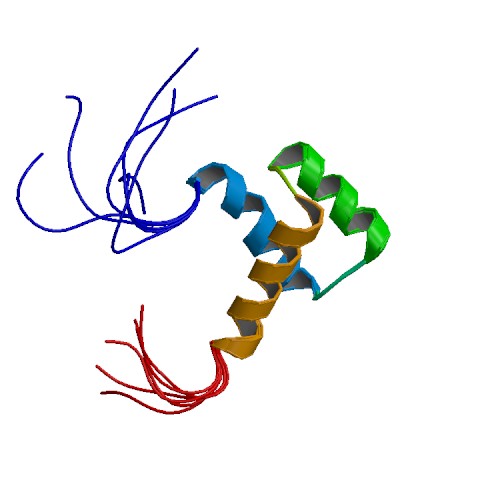HOXB13
| Homeobox B13 | |||||||||||||
|---|---|---|---|---|---|---|---|---|---|---|---|---|---|
 PDB rendering based on 2cra. | |||||||||||||
| |||||||||||||
| Identifiers | |||||||||||||
| Symbols | HOXB13 ; PSGD | ||||||||||||
| External IDs | Template:OMIM5 Template:MGI HomoloGene: 4640 | ||||||||||||
| |||||||||||||
| RNA expression pattern | |||||||||||||
 | |||||||||||||
| More reference expression data | |||||||||||||
| Orthologs | |||||||||||||
| Template:GNF Ortholog box | |||||||||||||
| Species | Human | Mouse | |||||||||||
| Entrez | n/a | n/a | |||||||||||
| Ensembl | n/a | n/a | |||||||||||
| UniProt | n/a | n/a | |||||||||||
| RefSeq (mRNA) | n/a | n/a | |||||||||||
| RefSeq (protein) | n/a | n/a | |||||||||||
| Location (UCSC) | n/a | n/a | |||||||||||
| PubMed search | n/a | n/a | |||||||||||
Homeobox B13, also known as HOXB13, is a human gene.[1]
This gene encodes a transcription factor that belongs to the homeobox gene family. Genes of this family are highly conserved among vertebrates and essential for vertebrate embryonic development. This gene has been implicated to play a role in fetal skin development and cutaneous regeneration. In mice, a similar gene was shown to exhibit temporal and spatial colinearity in the main body axis of the embryo, but was not expressed in the secondary axes, which suggests functions in body patterning along the axis. This gene and other HOXB genes form a gene cluster at chromosome the 17q21-22 region.[1]
See also
References
Further reading
- Maruyama K, Sugano S (1994). "Oligo-capping: a simple method to replace the cap structure of eukaryotic mRNAs with oligoribonucleotides". Gene. 138 (1–2): 171–4. PMID 8125298.
- Zeltser L, Desplan C, Heintz N (1996). "Hoxb-13: a new Hox gene in a distant region of the HOXB cluster maintains colinearity". Development. 122 (8): 2475–84. PMID 8756292.
- Shen WF, Montgomery JC, Rozenfeld S; et al. (1997). "AbdB-like Hox proteins stabilize DNA binding by the Meis1 homeodomain proteins". Mol. Cell. Biol. 17 (11): 6448–58. PMID 9343407.
- Suzuki Y, Yoshitomo-Nakagawa K, Maruyama K; et al. (1997). "Construction and characterization of a full length-enriched and a 5'-end-enriched cDNA library". Gene. 200 (1–2): 149–56. PMID 9373149.
- Stelnicki EJ, Arbeit J, Cass DL; et al. (1998). "Modulation of the human homeobox genes PRX-2 and HOXB13 in scarless fetal wounds". J. Invest. Dermatol. 111 (1): 57–63. doi:10.1046/j.1523-1747.1998.00238.x. PMID 9665387.
- Kosaki K, Kosaki R, Suzuki T; et al. (2002). "Complete mutation analysis panel of the 39 human HOX genes". Teratology. 65 (2): 50–62. doi:10.1002/tera.10009. PMID 11857506.
- Strausberg RL, Feingold EA, Grouse LH; et al. (2003). "Generation and initial analysis of more than 15,000 full-length human and mouse cDNA sequences". Proc. Natl. Acad. Sci. U.S.A. 99 (26): 16899–903. doi:10.1073/pnas.242603899. PMID 12477932.
- Kömüves LG, Ma XK, Stelnicki E; et al. (2004). "HOXB13 homeodomain protein is cytoplasmic throughout fetal skin development". Dev. Dyn. 227 (2): 192–202. doi:10.1002/dvdy.10290. PMID 12761847.
- Jung C, Kim RS, Lee SJ; et al. (2004). "HOXB13 homeodomain protein suppresses the growth of prostate cancer cells by the negative regulation of T-cell factor 4". Cancer Res. 64 (9): 3046–51. PMID 15126340.
- Gerhard DS, Wagner L, Feingold EA; et al. (2004). "The status, quality, and expansion of the NIH full-length cDNA project: the Mammalian Gene Collection (MGC)". Genome Res. 14 (10B): 2121–7. doi:10.1101/gr.2596504. PMID 15489334.
- Jung C, Kim RS, Zhang HJ; et al. (2005). "HOXB13 induces growth suppression of prostate cancer cells as a repressor of hormone-activated androgen receptor signaling". Cancer Res. 64 (24): 9185–92. doi:10.1158/0008-5472.CAN-04-1330. PMID 15604291.
- Zhao Y, Yamashita T, Ishikawa M (2005). "Regulation of tumor invasion by HOXB13 gene overexpressed in human endometrial cancer". Oncol. Rep. 13 (4): 721–6. PMID 15756448.
- Jung C, Kim RS, Zhang H; et al. (2005). "HOXB13 is downregulated in colorectal cancer to confer TCF4-mediated transactivation". Br. J. Cancer. 92 (12): 2233–9. doi:10.1038/sj.bjc.6602631. PMID 15928669.
- Symmans WF (2006). "Genomic testing for sensitivity of breast cancer to hormonal therapy". Clin. Cancer Res. 12 (7 Pt 1): 1954–5. doi:10.1158/1078-0432.CCR-06-0289. PMID 16609001.
- Goetz MP, Suman VJ, Ingle JN; et al. (2006). "A two-gene expression ratio of homeobox 13 and interleukin-17B receptor for prediction of recurrence and survival in women receiving adjuvant tamoxifen". Clin. Cancer Res. 12 (7 Pt 1): 2080–7. doi:10.1158/1078-0432.CCR-05-1263. PMID 16609019.
- Cazal C, Sobral AP, de Almeida FC; et al. (2006). "The homeobox HOXB13 is expressed in human minor salivary gland". Oral diseases. 12 (4): 424–7. doi:10.1111/j.1601-0825.2005.01218.x. PMID 16792730.
- Ma XJ, Hilsenbeck SG, Wang W; et al. (2006). "The HOXB13:IL17BR expression index is a prognostic factor in early-stage breast cancer". J. Clin. Oncol. 24 (28): 4611–9. doi:10.1200/JCO.2006.06.6944. PMID 17008703.
- Muthusamy V, Duraisamy S, Bradbury CM; et al. (2007). "Epigenetic silencing of novel tumor suppressors in malignant melanoma". Cancer Res. 66 (23): 11187–93. doi:10.1158/0008-5472.CAN-06-1274. PMID 17145863.
- Miao J, Wang Z, Provencher H; et al. (2007). "HOXB13 promotes ovarian cancer progression". Proc. Natl. Acad. Sci. U.S.A. 104 (43): 17093–8. doi:10.1073/pnas.0707938104. PMID 17942676.
External links
- HOXB13+protein,+human at the US National Library of Medicine Medical Subject Headings (MeSH)
This article incorporates text from the United States National Library of Medicine, which is in the public domain.
| This protein-related article is a stub. You can help Wikipedia by expanding it. |